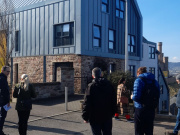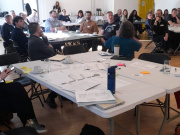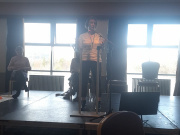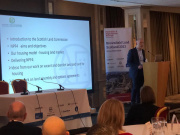
Housing and Land Re-use – a Common Problem with a Common Solution?
David Stewart
Over the last few months, I have attended and spoken at a number of housing and land conferences. While the events covered seemingly disparate themes – rural housing, town centre living and the re-use of vacant and derelict land – there was a common thread.
Attendees and speakers saw the need to increase development and activity to enable places to meet their potential and improve the lives of people living there. Yet each event wrestled with challenges to increase development in areas of market failure.
The Events
I attended five town centre living roadshows, the annual Rural Housing Scotland conference, and Brownfield Land Scotland.
Town Centre Living Roadshows
The Town Centre Living Roadshows were run by Scotland’s Towns Partnership with support from Architecture and Design Scotland, Scottish Futures Trust and the Scottish Land Commission. The events resulted from the A New Future for Scotland's Town Centres, which highlighted increasing town centre living as essential to creating successful thriving high streets. The events followed the Scottish Futures Trust’s Town Centre Living report, which highlighted the many benefits to town centre housing including affordable living, reduced carbon emissions and increases in active travel.
Rural Housing Scotland Annual Conference
The Rural Housing Scotland Annual Conference - Rural Futures, Rural Solutions - focused on two crucial issues for rural housing. Firstly, the need to repopulate fragile rural and remote opportunities, and secondly the importance of increasing delivery of new housing in the rural Scotland to secure the sustainable economic growth opportunities available in rural Scotland. This is a particularly urgent issue in the Highlands and Islands area, with Stuart Black of Highlands and Islands Enterprise setting out the scale of potential growth and the huge importance of new homes to ensuring communities across the region benefit from investment and growth.
Brownfield Land Scotland Conference
The Brownfield Land Scotland Conference focuses on the remediation regeneration and re-use of vacant and derelict sites in Scotland, looking at how policy and science can combine to bring empty sites and buildings back into productive use. It shared examples of remediation solutions while discussing policy approaches to encourage and enable re-use of land, including decontamination of sites polluted through past industrial uses.
A Common Theme
While the events would appear to cover very different topics, a common theme emerged. For each area there were challenges with market failure.
For vacant and derelict land, deindustrialisation has resulted in empty sites that are often contaminated and which may be complicated by multiple ownership. Demographic change added to the complications of assembling the sites resulting in sites lying empty for long periods.
For rural Scotland, while there is a well-documented need to increase housing to sustain communities, most rural areas suffer from market failure. Volume housebuilders, who deliver the bulk of new homes in Scotland, are largely inactive, unable to deliver the scale and profit levels that their business model demands.
"Volume housebuilders, who deliver the bulk of new homes in Scotland, are largely inactive, unable to deliver the scale and profit levels that their business model demands."
The decline of retail in high streets and the negative impact on town centres the length and breadth of Scotland has been well documented. In addition to regenerating historic hubs, town centre living can bring many benefits – providing homes close to amenities and jobs, re-using historic buildings and encouraging active travel while reducing car use. Work by the Scottish Land Commission and partners has found, however, that investment and development by the private sector is limited and below the levels needed to revitalise town centres and deliver much needed homes.
A Possible Solution?
For all three conferences, a possible solution was for the public sector to play an active role in assembling sites and initiating and shaping development. This is by no means a public sector takeover, but rather the public sector playing its role to provide the conditions that enable others (including communities, investors, housing associations and developers) to invest and develop with confidence.
Across the town centre roadshows we saw several examples of this including a Masterplan for Inverness City Centre, Renfrewshire Council investing in public realm and cultural assets to attract private sector housing, and Perth and Kinross working with communities and private owners to enable empty buildings to be re-used for housing.
At Rural Housing Scotland conference I heard how the Highland Land Bank had helped to unlock sites and deliver homes. There seems, though, to be an overreliance on communities as delivery agents and a need for more support. Support is needed to replicate and increase the good work delivered by community development trusts and housing enablers, but I would argue that new models of housing delivery are also needed to support growth and quality jobs.
Brownfield Land Scotland heard how local authorities and public agencies could create conditions to regenerate vacant land and support productive re-use, with the Leven Project a great example of how leadership from SEPA and Fife Council was enabling successful regeneration and re-use.
Next Steps for Scottish Land Commission
The Land Commission are involved in several significant pieces of work that may help provide solutions to the challenge of market failure highlighted at these events:
Vacant and Derelict Land
We commissioned Rydens to complete a review of progress with re-use of Vacant and Derelict Land. We will publish the review over the next few months, together with a briefing highlighting progress in land re-use and recommending ways to accelerate development and re-use of brownfield land.
Town Centre Living
We are working with Scotland’s Town’s Partnership, Scottish Futures Trust and Architectural and Design Scotland to collate the main lessons from the roadshows and further develop proposals to increase town centre living.
Rural Housing
The University of Glasgow are researching practical means to ensure that there is a supply of land in rural areas that can meet housing need and demand. Crucially this land needs to be developable and owned by someone keen to see housing delivered. We look forward to publishing the report in the next few months and contributing to discussions on how to ramp up the delivery of homes in rural Scotland.
You can find out more about the Scottish Land Commission’s work to reduce the land constraints to place-making and restrictions to the supply of land for housing in the Housing and Development area of our website. We also have a number of resources to help support the transformation of vacant and derelict land, helping to bring unloved places back into productive use.





